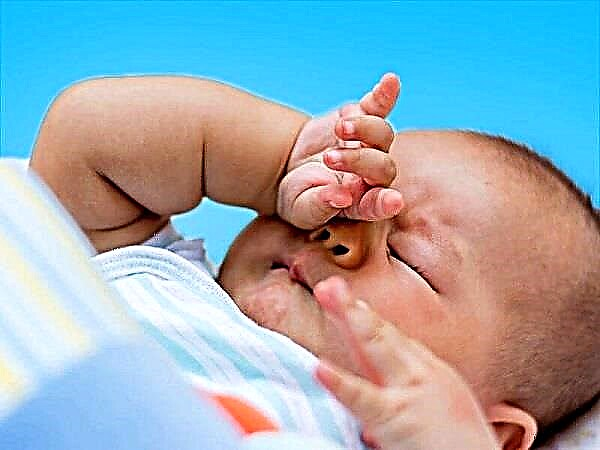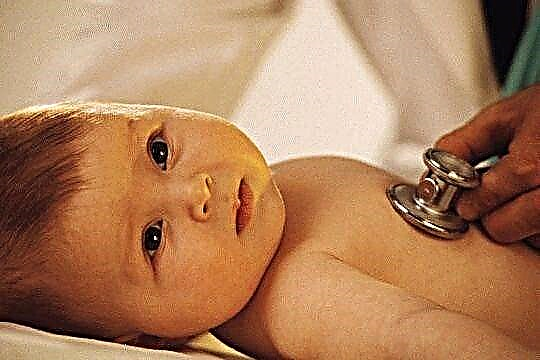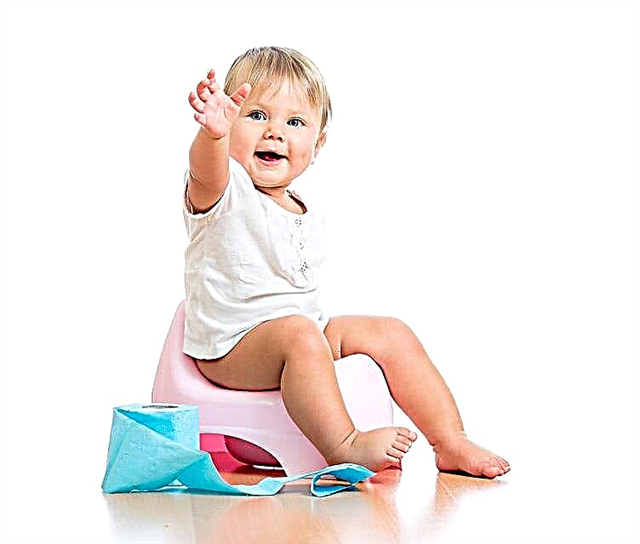Quite often, young parents begin to worry about the fact that their newborn does not open his eyes for a long time after birth. This is influenced by many factors. It is worth knowing in which cases this is the norm, and in which it is pathology, and you need to seek help from a doctor in order to start treatment in a timely manner.

The child rubs his eyes
Vision of a newborn baby after birth
Newborn babies see very differently from adults. Babies are not yet able to distinguish the outlines of small objects, but their pupils can already react to bright light. In the first month of life, the baby sees everything around him in black and white, since his eyes still do not perceive bright colors. The baby can very well see all large objects located at a level of 20-30 cm from his face, and perceive them.
Important! If a mother noticed that her child does not react to light, his eyes look in different directions, and his gaze is clouded, it is necessary to consult a specialist.

Baby crying
Physiological features of infant vision
Every newly-made mom is worried about the question of when the eyes of newborns open, and what they can already see. All babies have physiological, completely normal for them, hyperopia. From birth to 6-7 years old, their eyes continue to actively form. The baby's ability to see well increases every day. All changes in the body occur in stages in accordance with other areas of development.
Vision develops most actively before the age of 12 months:
- The first days of life. In the first hours and days of life, the baby cannot focus at all. All he sees is black and white spots and blurred outlines, located 40 cm from his eyes. The latter distinguish well between bright light and darkness. In response to a bright ray of light, the baby begins to blink, close his eyes, tries to cover his face with a pen. He can also flinch with his whole body. A baby may react to a sudden and bright light by crying loudly and unhappily.
- At 1 month old, the baby sees the face of mom and dad when they take him in their arms, and can even catch a smile on him.
- At 2 months, the baby monitors objects moving in a horizontal position and even tries to turn his head for this. He is not yet able to catch objects moving in a vertical direction. If earlier the baby saw a blurry image, then during this period of his life the sharpness of the image begins to appear.
- At 3 months, the baby sees a lot more, better and further. He can follow with interest the movement of objects, not only large, but also small, for a long time. Recognizes the faces of all family members.
- At 4 months, the baby is already well coordinating his movements and can grab the handle with the object that interests him.
- At 5 months, the child understands that objects exist even when he does not see them. He can also recognize familiar objects by their outlines or individual parts.
- At 6 months, three-dimensional visual perception is actively developing, the grasping reflex is improving. The baby learns to focus and hold his gaze on objects located nearby. Begins to perceive simple shapes.
Additional Information. The perception of color is formed gradually: at first, the baby begins to distinguish between red and give preference to it. He sees yellow next. The blue and green colors are the last thing the baby comprehends and realizes.

The newborn does not open his eyes
If the newborn has problems opening eyes
When do newborn eyes open? Normally, a child's eyes should open during the first breath. Sometimes this happens 3-5 minutes after birth, when the baby has already been placed on the mother's stomach. Also, the baby often opens his eyes very wide for the first time when he first enters the street.
There are situations when a newborn's eyes remain closed for several days. The reasons for this condition:
- Swelling of the soft tissues around the eyes. It can appear due to a birth injury when the face of the head is squeezed. Or edema occurs due to the long "standing" of the child in the small pelvis. With edema, the baby's eyelids enlarge, sometimes very much. Also, the skin can shine and turn red if an inflammatory process has begun in the eyelid.
- If the newborn baby's eyes do not open, an infection could be the cause. Congenital infections are common in infants, symptoms of which are swelling of the tissues around the eyes and forehead, accumulation of pus on the conjunctiva, and sticking of the upper and lower eyelids. Sometimes the eye is full of purulent discharge.
- The newborn does not open his eyes at all due to prematurity. In babies born prematurely, all organs, including the eyes, are immature, so their opening slows down, the eyelids begin to open 3-7 days after birth.
Note! If the child has already opened his eyelids, but suddenly stopped doing it, his eyes turned red and swollen, it is necessary to consult a pediatrician, possibly, there was infection with conjunctivitis.

Newborn has puffy eyes
When a newborn child opens his eyes completely, all parents should know, since it is by this sign that one can determine whether his organs of vision are healthy and whether he will see well. In case the baby cannot open his eyes in any way, it is worth contacting a doctor. He will conduct an inspection and determine what exactly the problem is.
If one eye does not open in a newborn at 2-5 days of life, this may be due to the development of conjunctivitis or a pathology such as ptosis, which requires immediate intervention. An increase in body temperature should also alert parents. This will be a symptom that an infection is developing in the crumbs' body. With purulent discharge, the baby needs help, since there is a high probability of the development of pathological processes inside the eye.
Possible reasons
- Ptosis. If a newborn has difficulty opening one eye, this may indicate that the baby has ptosis. Due to underdevelopment of the muscle that lifts the eyelid, or damage to the optic nerve, which controls the movement of this muscle, the upper eyelid drops. The drooping eyelid prevents light from entering the eye.
- Conjunctivitis. There is an inflammation of the conjunctiva - the outer transparent mucous membrane that covers the inner surface of the eyelids. In a newborn, this disease is accompanied by redness of the conjunctiva, swelling of the eyelids and the presence of mucopurulent discharge.
- Inflammation of the lacrimal sac (dacryocystitis). The baby has purulent tears flowing from the eyes, crusts form around the eyelids. The area of the lacrimal sac swells, becomes tense and red. This happens if the child has a membrane of the nasolacrimal canal, which normally should dissolve after birth, but it happens that it remains intact.

Baby crying
Baby Eye Care
When the eyes of newborns usually open, all mothers should understand. It is also important to know that when caring for the eyes of the crumbs, sterile conditions are above all, since an infection that can get on the mucous membrane can provoke the development of conjunctivitis and visual impairment in a child.
It is necessary to treat the eyes of a newborn baby according to the following rules:
- Wash your hands with soap and water and treat them with an antibacterial agent;
- Prepare a sterile bandage and chilled boiled water;
- Make a napkin from a bandage, moisten it in water;
- Wipe the eye very carefully, without pressing down on the eyeball. Movements should be from the outer corner to the inner corner (from ear to nose);
- Take a new piece of bandage and make a napkin;
- Rub the second eye.
This washing procedure should be done every morning after a night's sleep.
Important! If the child's eye turns sour, or pus is released, then the medicines for washing can be used only as directed by the doctor. It is better not to use decoctions of chamomile and other herbs, as they can cause an allergic reaction.
When to contact a specialist
It is necessary to unscheduled contact a children's optometrist in such cases:
- Lachrymation and discharge of pus from the eye of a newborn;
- The child does not open his eyes for a long time;
- The baby has swelling and redness of the eyelids;
- The eyes turn sour, after sleep it is impossible to open the cilia;
- There is no reaction of the pupils to light (they do not narrow);
- Increased sensitivity to light;
- The child does not follow a moving object with both eyes: horizontally - at the age after 2 months, vertically - at the age after 3-4 months;
- The child's pupils twitch, run, blink, cannot stay at one point;
- The child cannot focus on a close object (from 2 months);
- The eyes of a newborn baby are very prominent;
- The eyes of a newborn are squinted after three months of age;
- There has been contact with the eyes of foreign substances or foreign bodies;
- There was an eye injury.
In order to avoid various diseases and defects associated with the eyes of newborns, examination and diagnosis are necessary. Only in such cases will it be possible to avoid eye diseases in the child or to cure the disease at the earliest stages.



